
- Exploring the Ancient Roman Ruins in Barcelona
- A Comprehensive Guide to the City History Museum
- Top 5 Must-See Roman Artifacts at the Museum
- Understanding the Significance of Roman Architecture in Barcelona
- How to Plan Your Visit to the City History Museum
- The Cultural Impact of Roman History on Modern Barcelona
Barcelona, a city rich in history and culture, invites visitors to uncover its ancient past through its remarkable attractions. One of the most captivating experiences is to Explore Roman Ruins at Barcelona City History Museum, where the remnants of the Roman Empire come to life beneath the vibrant streets of this modern metropolis.
At the museum, guests can wander through well-preserved archaeological sites that tell the story of Barcelona's origins as a Roman settlement. The fascinating exhibits and guided tours provide insight into daily life during ancient times, making it a must-visit destination for history enthusiasts.
Exploring the Ancient Roman Ruins in Barcelona
As you embark on your journey to explore the ancient Roman ruins in Barcelona, you'll find that the city offers a fascinating glimpse into its past. The remnants of Roman architecture, such as the impressive walls of the ancient city of Barcino, are not just historical artifacts but also a testament to the advanced engineering of that era. Walking along these ancient streets allows visitors to imagine the bustling life that once thrived here.
In addition to the remarkable structures, the museum features various interactive displays that enhance the educational experience. Visitors can learn about key aspects of Roman life, including:
- Daily routines and social structures
- Culinary traditions and ancient recipes
- Trade practices and economic systems
These elements combine to create a vivid picture of Roman society and its influence on modern Barcelona.
Another highlight of visiting the Roman ruins is the opportunity to explore the Roman Forum, which served as the political and social hub of Barcino. Here, you can see the foundations of temples and public buildings that reflect the city’s importance during the Roman Empire. The layout of the forum can be compared to other major Roman cities, showcasing how Barcelona fit into the larger narrative of Roman history.
For those who wish to delve deeper, guided tours are available that provide expert insights into the archaeological significance of the ruins. These tours often include:
- Access to lesser-known sites
- Detailed discussions on specific artifacts
- Engaging storytelling that brings history to life
By participating, visitors gain a richer understanding of how the ancient Romans shaped the cultural landscape of modern Barcelona.
A Comprehensive Guide to the City History Museum
The City History Museum of Barcelona is an essential destination for anyone interested in the rich tapestry of the city's past. Located in the heart of Barcelona, the museum offers a unique opportunity to explore the archaeological remains of the ancient Roman city of Barcino. Visitors can step back in time as they walk through the well-preserved ruins, which serve as a testament to the city's historical significance during the Roman Empire.
Inside the museum, you'll discover an array of interactive exhibits that provide insight into Roman life and culture. The displays cover various aspects of daily life, including:
- Architectural advancements
- Religious practices
- Artistic expressions
This engaging approach not only educates visitors but also immerses them in the historical context of the artifacts on display.
One of the museum's key features is its well-curated guided tours, which focus on the Roman ruins scattered throughout the site. These tours offer a chance to explore various highlights, such as:
- The ancient city walls
- The remnants of the Roman Forum
- Historic residential areas
By participating in these tours, guests gain a deeper appreciation for the cultural layers that have shaped modern Barcelona.
For those looking to enhance their visit, the museum often hosts special events and workshops that delve into specific themes related to Roman history. These events are designed to engage visitors of all ages and provide a comprehensive understanding of how the Roman Empire influenced Barcelona's development over the centuries.
Top 5 Must-See Roman Artifacts at the Museum
When visiting the Barcelona City History Museum, you cannot miss the stunning collection of Roman artifacts that offer a glimpse into the life of ancient Barcino. Here are the top 5 must-see Roman artifacts that stand out for their historical significance and craftsmanship:
- The Mosaics: Beautifully preserved, these intricate mosaics depict various scenes of daily life and mythology, showcasing the artistic talent of the time.
- The Roman Tombs: These burial sites provide insight into Roman funeral practices and beliefs about the afterlife, complete with inscriptions and offerings.
- The Column of the Temple of Augustus: A striking remnant of the city's former glory, this column is a testament to Roman architectural prowess and religious practices.
- The Pottery Collection: A diverse array of pottery items, ranging from utilitarian vessels to decorative pieces, reveals much about the trade and daily life in Roman Barcelona.
Each of these artifacts not only demonstrates the artistic and practical skills of the Romans but also serves as a bridge connecting modern visitors to their ancient history. The museum does an excellent job of providing context through informative displays that enrich the experience.
Among the artifacts, the mosaics stand out for their colorful designs and intricate patterns. They were often used to decorate public buildings and wealthy households, illustrating the importance of art in Roman culture. Additionally, the Roman tombs tell stories of the individuals who once inhabited the city, linking their narratives to the broader historical themes of life and death in ancient Rome.
Furthermore, the Column of the Temple of Augustus is an iconic representation of the religious life in Barcino. Standing tall and proud, it invites visitors to ponder the significance of religion during the Roman Empire. Lastly, the extensive pottery collection offers a tangible connection to everyday Roman life, highlighting trade routes and social customs.
Understanding the Significance of Roman Architecture in Barcelona
Understanding the significance of Roman architecture in Barcelona unveils a fascinating layer of the city's rich history. The remnants of ancient structures, such as the city walls and public buildings, reflect advanced engineering techniques and architectural styles that were revolutionary for their time. These historical sites not only highlight the importance of Barcino in the Roman Empire but also serve as a foundation for the city's urban development.
One of the most compelling aspects of Roman architecture is its influence on later styles. The use of arches, aqueducts, and intricate mosaics established a blueprint that would shape European architecture for centuries to come. In Barcelona, visitors can marvel at the following features:
- The City Walls: Massive fortifications that once protected Barcino.
- Temples and Forums: Centers of political and social life, showcasing Roman civic values.
- Residential Structures: Remnants that illustrate the daily lives of its inhabitants.
Moreover, the study of Roman ruins provides insights into the daily life and cultural practices of the time. Artifacts such as pottery, tools, and inscriptions reveal the complexities of Roman society, from trade networks to social hierarchies. Understanding these elements allows visitors to appreciate how the past has shaped the cultural landscape of modern Barcelona.
Finally, the preservation of these ancient sites emphasizes the importance of historical conservation. Initiatives aimed at protecting and restoring Roman architecture ensure that future generations can experience and learn from the city's vibrant past. Engaging with these ruins not only enriches our knowledge of history but also fosters a deeper connection to the cultural identity of Barcelona.
How to Plan Your Visit to the City History Museum
When planning your visit to the City History Museum, it is essential to check the museum's official website for up-to-date information on opening hours and ticket prices. The museum is typically open from Tuesday to Sunday, with specific hours that may vary seasonally. Purchasing tickets online in advance can save you time and ensure you secure your spot, especially during peak tourist seasons.
Consider allocating at least two to three hours for your visit to fully explore the museum's extensive exhibits and the Roman ruins. To enhance your experience, it is advisable to join a guided tour, which often includes detailed insights into the history and significance of the artifacts. You may also want to download any available audio guides to enrich your understanding as you wander through the exhibits.
If you are traveling with family, check the museum's schedule for special events or workshops that cater to children. These interactive programs can significantly enhance the experience for young visitors, making history more engaging. Additionally, be sure to wear comfortable walking shoes, as exploring the archaeological sites involves navigating various terrains.
Lastly, don’t forget to visit the museum's gift shop, where you can find unique souvenirs related to Roman history and culture. Items such as replicas of artifacts, educational books, and even local crafts make for perfect mementos of your journey through the ancient past of Barcelona.
The Cultural Impact of Roman History on Modern Barcelona
The cultural impact of Roman history on modern Barcelona is profound, influencing not just architecture but also the city’s social and artistic fabric. The remnants of the Roman era, such as the ancient city walls and public forums, serve as powerful reminders of a time when Barcelona, known as Barcino, played a significant role in the Roman Empire. This historical backdrop enriches the city’s identity, embedding Roman traditions into its contemporary culture.
Moreover, the legacy of Roman engineering is evident in Barcelona’s infrastructure. The city utilizes elements such as aqueducts and roads originally designed by Roman architects, which have evolved yet remain crucial for urban planning today. This architectural heritage is celebrated through various
- Festivals that honor Roman history
- Art installations inspired by ancient themes
- Educational programs focused on Roman contributions
that promote an understanding of the city’s roots among residents and visitors alike.
Another significant aspect of this cultural impact is the influence of Roman law and governance on modern Barcelona. The principles of civic engagement and community rights established during Roman times have shaped contemporary legal frameworks and social structures. This historical continuity is apparent in the way local governance operates today, reflecting a blend of ancient practices with modern innovations.
Finally, the artistic expressions that emerged during the Roman period continue to inspire contemporary artists in Barcelona. From murals that depict historical narratives to sculptures that honor ancient figures, the city showcases a vibrant artistic scene that pays homage to its Roman heritage. This ongoing dialogue between past and present reinforces a collective cultural memory, making Roman history an integral part of Barcelona’s identity.
 Les célèbres œuvres de Gaudí à Barcelone
Les célèbres œuvres de Gaudí à Barcelone Barcelona's Gothic Quarter: Roman Roots
Barcelona's Gothic Quarter: Roman Roots The Magnificent Montserrat Monastery Museum: A Treasure Trove of History and Art
The Magnificent Montserrat Monastery Museum: A Treasure Trove of History and ArtIf you want to know other articles similar to Explore Roman Ruins at Barcelona City History Museum you can visit the category WHERE YOU CAN GO.
Deja una respuesta










Read more!